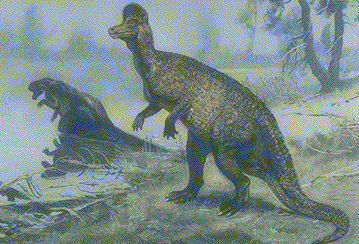48. Tranquil Corythosaurus, 1957
 During the
post-war years, the figures from the Zallinger mural greatly influenced public
perceptions of dinosaurs in the United States. In central Europe, the foremost
painter of dinosaur restorations was Zdenek Burian. His canvases were used to
illustrate a number of popular books on prehistoric life by Joseph Augusta, and
in the the late 1950s and 1960s these were translated into English and widely
circulated. So the Burian illustrations offered an alternative to those of
Zallinger, or of the late Charles Knight. But there was not much of a
difference. Apatosaurus and Diplodocus stand quietly by their
respective swamps, accompanied by partially submerged relatives. A
Tyrannosaurus besets a pair of Trachodon, but none of the three
lifts a leg off the ground, or even seems to be moving at all.
During the
post-war years, the figures from the Zallinger mural greatly influenced public
perceptions of dinosaurs in the United States. In central Europe, the foremost
painter of dinosaur restorations was Zdenek Burian. His canvases were used to
illustrate a number of popular books on prehistoric life by Joseph Augusta, and
in the the late 1950s and 1960s these were translated into English and widely
circulated. So the Burian illustrations offered an alternative to those of
Zallinger, or of the late Charles Knight. But there was not much of a
difference. Apatosaurus and Diplodocus stand quietly by their
respective swamps, accompanied by partially submerged relatives. A
Tyrannosaurus besets a pair of Trachodon, but none of the three
lifts a leg off the ground, or even seems to be moving at all.
The restoration of Corythosaurus, painted in 1955 (see above),
shows one specimen standing semi-upright, with its tail on the ground, while
another contemplates its reflection in the water. The pose of the foreground
figure had been the standard ornithopod stance since Dollo's
restoration of Iguanodon, and it would continue to be so until the
1970s.
One of Burian's other paintings shows a Brachiosaurus submerged up to
its eyeballs in water. The notion of snorkeling sauropods is an interesting
sidebar in the history of dinosaur restoration; click
here for details. To see Tyrannosaurus
and Trachodon, click here.
 Source:
Source:

 ®Linda Hall Library
®Linda Hall Library During the
post-war years, the figures from the Zallinger mural greatly influenced public
perceptions of dinosaurs in the United States. In central Europe, the foremost
painter of dinosaur restorations was Zdenek Burian. His canvases were used to
illustrate a number of popular books on prehistoric life by Joseph Augusta, and
in the the late 1950s and 1960s these were translated into English and widely
circulated. So the Burian illustrations offered an alternative to those of
Zallinger, or of the late Charles Knight. But there was not much of a
difference. Apatosaurus and Diplodocus stand quietly by their
respective swamps, accompanied by partially submerged relatives. A
Tyrannosaurus besets a pair of Trachodon, but none of the three
lifts a leg off the ground, or even seems to be moving at all.
During the
post-war years, the figures from the Zallinger mural greatly influenced public
perceptions of dinosaurs in the United States. In central Europe, the foremost
painter of dinosaur restorations was Zdenek Burian. His canvases were used to
illustrate a number of popular books on prehistoric life by Joseph Augusta, and
in the the late 1950s and 1960s these were translated into English and widely
circulated. So the Burian illustrations offered an alternative to those of
Zallinger, or of the late Charles Knight. But there was not much of a
difference. Apatosaurus and Diplodocus stand quietly by their
respective swamps, accompanied by partially submerged relatives. A
Tyrannosaurus besets a pair of Trachodon, but none of the three
lifts a leg off the ground, or even seems to be moving at all.